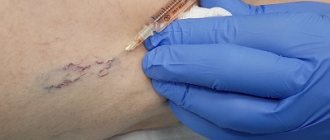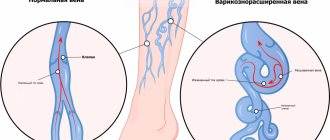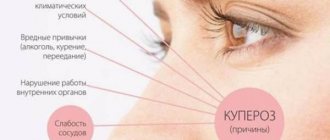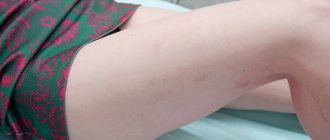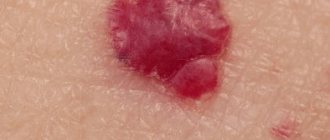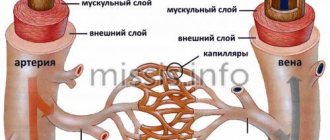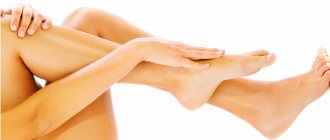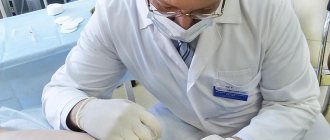Table of contents
- Etiology and pathogenesis
- Clinical manifestations
- Principles of treatment, hardware methods for treating rosacea
Cuperosis (dilated capillaries, couperose-prone skin, couperosa) is a persistent local expansion of small capillaries with thickening and a pronounced decrease in the elastic properties of their walls, as well as blood stagnation. Unlike rosacea, it almost never goes away on its own.
In our company you can purchase the following equipment for the treatment of rosacea:
- M22 (Lumenis)
- AcuPulse (Lumenis)
- Fraxel (Solta Medical)
- UltraPulse (Lumenis)
There are no statistical data on rosacea as an independent nosology, however, it is believed that, together with rosacea, rosacea affects from 1% to 22% of the population, depending on the region of residence.
Reasons for the appearance of stars on legs
The main cause of spider veins on the legs is hormonal imbalance, including those caused by taking oral contraceptives. This explains why telangiectasia affects more women than men. Other reasons include the following:
- genetic predisposition
- pregnancy
- chronic skin diseases, including rosacea
- overweight
- increased load on the legs
- excessive exposure to solar radiation
- hypertension
- endocrine pathologies
- chronic venous insufficiency
- bad habits (in particular, smoking) and others.
Etiology and pathogenesis
The etiological factors of rosacea can be divided into endogenous and exogenous.
Endogenous factors include the influence of heredity. A decrease in the elasticity of the vascular wall is a genetically determined condition, which can be aggravated by various provoking (exogenous) factors - heat, cold, hormonal imbalance, somatic diseases, weakness of the valve apparatus of the veins of the lower extremities, etc.
Among the exogenous factors, it is worth highlighting the following:
- Nervous strain - in this case, large main vessels narrow, which increases the pressure in them, and the vessels of the peripheral network, on the contrary, expand.
- Smoking - promotes spasm and decreases the strength of the vascular wall.
- Diet - too hot, spicy or salty food, frequent and/or heavy consumption of alcoholic beverages provoke exacerbation and progression of rosacea.
- Climate - this includes ultraviolet radiation, prolonged exposure to strong gusty winds, cold or too hot and humid climate.
- Lifestyle - rosacea can worsen after visiting a sauna or bathhouse, with mechanical pressure on the skin (wearing tight synthetic clothing), while working with formaldehyde, etc.
Food triggers for rosacea are similar to those for rosacea. This includes hot tea and coffee, wine, strong alcohol, products with capsaicin (spices, hot sauces, hot and red peppers) and with cinnamaldehyde (tomatoes, chocolate, citrus fruits).
There is evidence that disruption of the microbial composition of the skin can provoke dysfunction of the epidermal barrier, which increases the skin's sensitivity to external factors and contributes to the development of rosacea.
Cuperosis and vascular network on the face
As we mentioned earlier, this is a superficial manifestation of blood vessels on our skin. Many things can provoke this effect. An elementary increase in temperature, a contrasting transition after a winter street and frost into a warm room, excitement, stress or another reaction of the body when blood circulation increases and blood vessels lose their elasticity and expand. All this can appear on the surface of the skin in the form of unpleasant reddish “patterns”. They are often accompanied by side effects that further negatively affect the condition of the skin: the skin “burns” and dries, peeling and itching appear. Sometimes such irritation even leads to skin injury. All this is very sad and does not contribute to a good mood and confidence in one’s beauty.
Make an appointment at the clinic on Vasilyevsky Island
Sign up
Clinical manifestations
There are 4 stages of rosacea:
- Stage 1 - under certain conditions (for example, in a hot room with dry air), the patient may experience erythema and irritation on the face. Against the background of erythema, several dilated capillaries become noticeable.
- Stage 2 - gradually dilated capillaries unite into a network, and the vessels are colored more brightly.
- Stage 3 - congestive erythema appears with individual or multiple telangiectasias. A network of dilated capillaries, mainly in the central third of the face, becomes clearly visible.
- Stage 4 - the visibility of capillaries increases, vessels on the entire surface of the face are involved in the pathological process. Areas of local blanching appear as a result of capillary spasm.
By studying the etiological factors and assessing the clinical manifestations of rosacea, we can conclude that this condition is similar to rosacea. Indeed, they have a lot in common - there is even an opinion that rosacea is the next stage in the development of rosacea. However, with rosacea, large and small vessels are affected, while with rosacea, only small ones are affected. Other differences between these pathologies are presented in table. 1 .
Table 1. Main differences between rosacea and rosacea
| Characteristic | Cuperosis | Rosacea |
| Localization | Typically occurs on the nose, cheeks and cheekbones. | Usually the central third of the face is affected - the cheeks and wings of the nose. |
| Epidemiology | It is observed in adults of any gender and age, but more often after 40 years. | It is observed in women aged 35–65 years with fair skin, most often in menopause. |
| Etiology | Inheritance, stress, smoking, climate, lifestyle. | Inheritance, Demodex mites, disruption of the immune system, abnormal signal transmission to blood vessels, microflora dysbiosis. |
| Clinic | The main symptom is telangiectasia, the number of which increases over time. In the future, the skin may become flabby and dry, and peeling occurs. With rosacea, triggers cause dilation of blood vessels, which subsequently do not narrow to normal diameter. | Erythema and telangiectasia on the cheeks and forehead, inflammatory papules and pustules - mainly in the nose, forehead and cheeks. When the lesion affects the sebaceous glands, rhinophyma may occur. In the ophthalmic type, injection of conjunctival vessels is observed. |
| Flow | Chronic, almost never goes away on its own. | Chronic, in mild cases it can go away on its own when the provoking factors (triggers) are eliminated. |
Our second heart is all about capillaries
We are very often concerned about the condition of blood vessels - we all know that problems with them can lead to the most unpleasant diseases, including stroke, varicose veins, and heart attack. And practically no one is interested in what condition are his capillaries in? We don't take capillaries seriously. And completely in vain. It turns out that they are responsible for our health and the proper functioning of the circulatory system. What are capillaries?
Capillaries are the smallest blood vessels that permeate our entire body. August Krogh calculated that the length of all capillaries is almost 100,000 km. In the kidneys alone there are 60 km of capillaries.
They cannot be seen with the naked eye and therefore are able to deliver blood, and therefore nutrients and oxygen, everywhere. They cover our body like a web. If capillary circulation stops in some part of the body, the flow of oxygen and nutrients stops there. The tissues begin to starve and then die. It follows that capillaries play a vital role in the body. By and large, they are even more important than large vessels, because only they can deliver blood to the most remote corners of the body. What else is the role of capillaries? We'll talk about this on our website a2news.ru.
The diameter of the capillaries is from 5 to 30 microns. Moreover, these vessels have an amazing ability - they can change their diameter almost 2-3 times, expanding or narrowing. If the capillaries narrow to a minimum, then they will not allow even blood cells to pass through - only blood plasma. When the capillaries expand to their limit, red and white blood cells perfectly enter their lumen.
Cells of capillary vessels are also capable of phagocytosis, which cells of other vessels cannot. They can devour aged red blood cells, cholesterol deposits, and microorganisms. Nutrients and blood plasma can penetrate through the walls of capillaries - it is thanks to this quality that the body tissues are nourished.
The role of capillaries
The narrowing and expansion of capillaries is extremely important for us. Interestingly, they contract in unison with other vessels. According to research, the narrowing of capillaries is accompanied by an increase in pressure, and their expansion is accompanied by a decrease. Any processes occurring in the body are accompanied by a narrowing or expansion of capillaries.
If everything is fine in the body, then the capillaries allow small molecules to pass through, that is, only what they should deliver - gases, salts, water. Once inflammation occurs or capillary cells are damaged, the capillaries begin to allow much larger molecules to pass through. Permeability increases, which we see immediately when we detect swelling. Or after some time, faced with the consequences of slagging of tissues, the accumulation of decay products, cholesterol waste, pigments, fats in them.
The great physiologist and physician A. Zalmanov called capillaries the second heart. He assigned the main role in blood circulation to the capillaries, which, constantly contracting and expanding, deliver blood to every cell of the body. This assumption was confirmed in 1936 by Weiss and Wang, who saw the work of blood vessels using capillaroscopy. French researchers Racine and Baruch examined the condition of capillaries using capillaroscopy in many patients. They found that chronic fatigue syndrome and weakness are also accompanied by impaired capillary blood circulation in tissues.
Interestingly, in the morning the capillaries have a smaller diameter, and in the evening they expand. This is precisely what is associated with the acceleration of metabolism in the evening and the increase in temperature. In winter and autumn, capillaries narrow more than in summer. Some researchers believe that this is precisely the reason that many diseases worsen during this period. During radiotherapy, the number of skin capillaries is reduced. And this is also the reason why people feel unwell after this procedure.
Based on studying the role of capillaries, Zalmanov concluded that disruption of the functioning of capillaries is to blame for the development of many diseases. Their unbalanced reduction and death or blockage lead to illness and death. At the same time, a person grows old and dies from the well-known diseases of old age. And the cause of aging is aging and disruption of capillaries. Zalmanov's followers argue that without studying capillaries and their role, medicine will never understand the true causes leading to diseases. In support of this opinion, it must be said that many diseases are still said: the cause of their occurrence (etiology) is not known for certain.
To briefly summarize, capillaries are designed to ensure complete metabolism, gas exchange in tissues, are involved in the synthesis of proteins, the processing of aging cells, and are a barrier to infections.
What does disruption of capillaries cause?
It has already been proven that varicose veins begin with impaired blood circulation in the venous capillaries. And only then the process occurs in other, larger veins.
The most mysterious and difficult to treat, Raynaud's disease and Meniere's syndrome, manifested by persistent dizziness, are characterized by stagnation and spasm of the capillaries. In general, researchers have discovered disruptions in the functioning of capillaries in a huge number of diseases, ranging from influenza and diphtheria to renal eclampsia and vegetative-vascular dystonia.
What happens to the capillaries? Under certain conditions, the membranes of the cells that make up the capillaries thicken, and then the capillaries become impenetrable. In other cases, the cells shrink and the distance between them increases - the capillaries, on the contrary, become too permeable. This often occurs with inflammatory diseases and injuries. A calendar will always be a necessary gift, and if you decorate it with a collage of photos of you and your loved ones, it will be doubly pleasant. An individual design for your calendar will be made on the website https://copy.spb.ru/poligr_prod/kalendari/ and you will become the owner of a unique souvenir. In addition, Copy Center has the opportunity to use delivery throughout St. Petersburg, so you don’t have to go to pick up a ready-made order. That's when swelling appears. Cells may also swell or collapse.
Changes in cells and capillary membranes, according to the latest information, underlie diseases such as:
elephantiasis; phlebitis; arteritis; pericarditis; endocarditis; heart attack; pulmonary diseases; nephritis; pyelonephritis; nephrosis; gastrointestinal diseases; glaucoma; cataract; eczema
A number of researchers argue that the basis of all diseases, to one degree or another, is a disruption of the capillaries. To successfully cure a disease, you must first restore the permeability of the capillaries and their healthy state.
Conclusion
The respiration of all cells of our body, their nutrition and life depend on the state of the capillary system. But modern medicine has almost forgotten about this important role of the capillary system, being carried away by medicinal effects, which are more reminiscent of patching up holes and the consequences of disorders, rather than a comprehensive treatment of their causes. Now the time has come to remember the old physiology textbooks and reassess the role and importance of the capillary system.
Interesting Facts
When an organ of the body is at rest, many of its capillaries are narrowed and almost do not work. As soon as a state of activity occurs, the capillaries expand and begin to intensively supply the organ with blood. Sometimes the blood supply increases 700 times!
The capillary system contains 80% of the total blood volume.
At rest, only a quarter of all capillaries work. When active, the entire capillary system begins to work.
How to restore health to capillaries
Dr. Zalmanov sincerely believed that the basis of aging is the aging of the capillary network, or rather, its gradual fading and the failure of larger and larger sections of it. Turning off the capillaries and closing them gradually leads to the fact that metabolism is disrupted, the body ceases to renew itself as in its youth, and becomes decrepit. Diseases that develop due to disruption of the capillaries complete the job.
What to do to break the vicious circle and prevent the development of heart attack, stroke and other unpleasant diseases of old age? Bring back youth to the capillary network! Many researchers, including Zalmanov, have developed a method for rejuvenating capillaries.
1. Special exercises
Simple but effective exercises have been developed to train and open the capillaries. The easiest of them is vibration. This exercise consists of lifting your arms and legs while lying down and performing oscillatory vibrating movements. Performing this exercise daily in the morning activates the capillary system and rejuvenates the body, speeds up metabolic processes.
Any physical activity strengthens capillaries well and makes them healthier.
2. Massage
Massage using the Kuznetsov applicator is especially welcome.
3. Contrast shower
Pouring alternately hot and cold water has a magical effect on the capillary system. If you use a special nozzle for Alekseev’s shower, the effect will be even greater.
A Russian bath with coronal massage and contrasting douches is considered one of the best ways to heal blood vessels.
4. Turpentine baths
Dr. Zalmanov proposed another way to open frozen capillaries - turpentine baths. They allow you to expand capillaries, open long-closed vessels, restore the capillary network and contribute to the overall health of the body.
Today, two types of turpentine emulsions have been developed - yellow and white. The yellow emulsion is used to improve the health of people with high blood pressure, the white emulsion is used for low blood pressure. For a complex effect, it is recommended to mix emulsions in equal proportions.
Again, the benefits of baths will only be if they are done regularly.
In a healthy body, capillaries work like clockwork. But if the capillary network has stopped coping with the job and the first signs of chronic tissue starvation appear, it’s time to take care of the most silent workers - the capillaries. It’s amazing how many diseases and ailments you can get rid of if you start doing simple and easy capillary exercises every day!
- News
Principles of treatment, hardware methods for treating rosacea
The primary treatment strategy for rosacea is avoidance of trigger factors . Each patient has an individual set of such factors and is determined empirically. Avoiding triggers is necessary to avoid exacerbations and progression of the disease.
An important therapeutic point is the fight against stress . Normalization of the psycho-emotional state and, in particular, the work of the autonomic nervous system helps prevent exacerbations of rosacea and its further aggravation.
One non-medicinal method is the use of cosmetics . Properly selected makeup hides redness of the skin and allows such patients to feel comfortable in public places.
UV filters every day . Preference should be given to physical filters - zinc oxide and titanium dioxide, as they are better suited for sensitive skin.
Among the cosmetic ingredients for rosacea, the following are recommended: horse chestnut (Aesculus Hippocastanum), nettle extract (Urtica Dioic Extract), ivy extract (Hedera Helix Leaf Extract), Asian centella extract (Centella Asiatica Extract), green tea extract (Camelia Sinensis Leaf Extract) , blueberry extract (Vaccinium Angustifolium Extract), vitamin K.
For rosacea, you can use electrosurgery - this method is suitable for removing small and medium-sized vessels. It is recommended to use multiple short microcoagulations at low energy levels with a distance of 1–2 mm between them. You should start with the most visible vessels and gradually move towards the center of the face.
Medicinal methods (for example, topical digoxin) have a rather weak effect, but can be used as maintenance therapy.
A real breakthrough in the treatment of rosacea has become methods of percutaneous photocoagulation of blood vessels , which are implemented using various lasers, as well as IPL systems. The principle of operation of all these devices is selective photothermolysis: heating and destruction (thermolysis) of surface vessels due to the selective absorption of radiation by hemoglobin.
The most common option is to use IPL therapy, such as M22-IPL. Treatment of rosacea with IPL is characterized by simplicity, high speed of procedures and a minimal rehabilitation period. In some cases, IPL therapy is combined with the use of an Nd:YAG laser: this is justified when it is necessary to coagulate deep-lying large vessels.
Questions from our users:
- rosacea treatment with pharmaceuticals
- rosacea cosmetology treatment
- rosacea professional cosmetics
- rosacea laser treatment or photorejuvenation
Capillary mesh on the face: tolerate or remove?
You probably know and have seen where such a mesh pattern on the face is most pronounced. Most often, patients come to us who have thin red lines of blood vessels appearing on their face. The cheeks, nose, and sometimes the chin or forehead are especially affected. This not only complicates the health situation and makes you think about the state of the cardiovascular system, but is also an aesthetic problem.
When thinking about removing capillary mesh on your face, you must understand that procedures and doctor’s advice alone will not be enough. It is important to minimize the impact of internal and external irritants to help your skin recover, strengthen and glow.
Modern clinics offer various ways to remove venous mesh on the face:
- photocoagulation (laser exposure);
- electrocoagulation (exposure to electric shock);
- phototherapy (there are different techniques);
- ozone therapy (exposure to ozone gas)
- sclerotherapy (introduction of special compounds directly into the vessels);
- radio wave surgery.
All methods and techniques have their own specifics. If you decide to remove the vascular network on your face, you should choose them together with a qualified specialist, preferably one who has a medical education and experience in working with similar cases. Don't be afraid to ask questions, because we are talking about your health and appearance.
In our clinic, all cosmetologists are educated in the medical field and know how to select the right treatment for spider veins. We practice laser removal. The method of using a laser to solve the problem of vascular pattern is called effective, powerful and safe.
